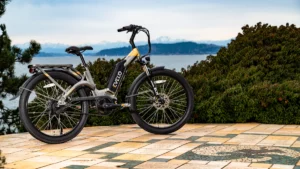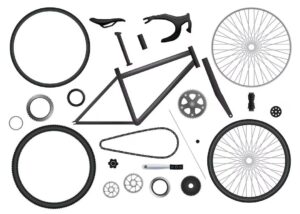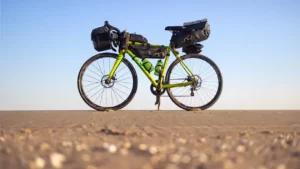आज बाइक चोरी विश्व स्तर पर साइकिल चालकों के लिए एक प्रमुख चिंता के रूप में करघे, इस प्रकार एंटी-चोरी बाइक लॉक चुनना सर्वोपरि है. अपनी बाइक को प्रभावी ढंग से सुरक्षित करने के लिए, विभिन्न लॉक प्रकारों की विशिष्ट विशेषताओं और कार्यों को समझना महत्वपूर्ण है. यह लेख पता लगाएगा 4 सामान्य प्रकार: यू लॉक, केबल ताले, चेन लॉक, और तह ताले. क्या आप तैयार हैं? चलो चलते हैं.
सामान्य प्रकार के बाइक ताले
ए बाइक का ताला एक निश्चित ऑब्जेक्ट के लिए साइकिल सुरक्षित करके चोरी को रोकने के लिए एक सुरक्षा उपकरण है, जैसे बाइक रैक या पोल, आमतौर पर एक संयोजन या कुंजी तंत्र का उपयोग करना. यह एक आवश्यक गौण है जब एक साइकिल सुरक्षित करता है. सुरक्षा स्तर बढ़ाने के लिए, यह विभिन्न प्रकार के साथ आता है. इस हिस्से में, हम यू लॉक के बीच के अंतर को सीखेंगे, तह ताले, चेन लॉक, और केबल ताले, जो साइकिल चालकों के लिए महत्वपूर्ण हैं कि वे अपनी बाइक को प्रभावी ढंग से सुरक्षित रखें.
यू लॉक
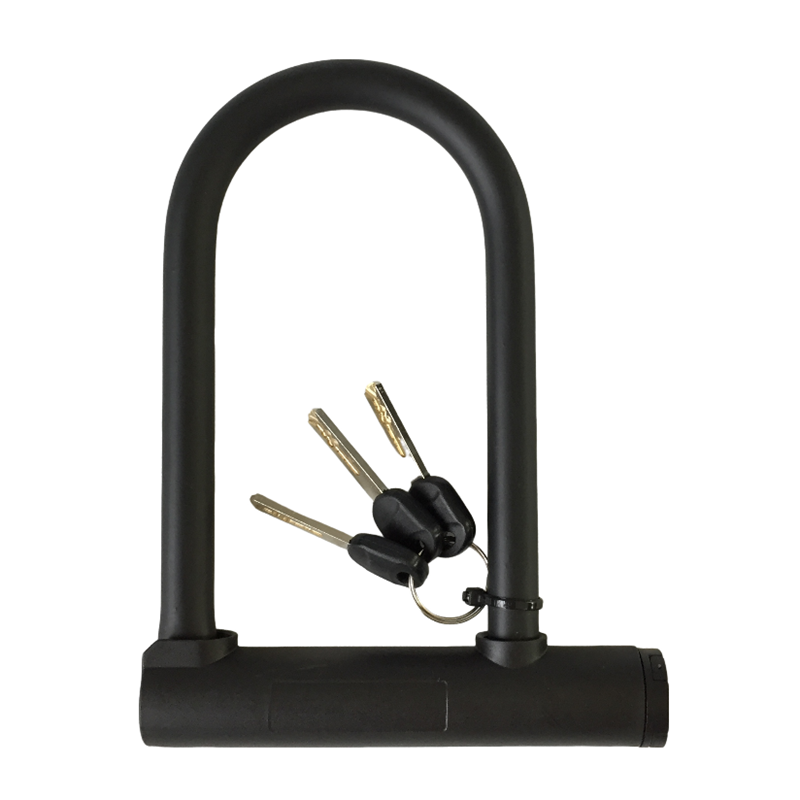
यू-ताले, यू-आकार के ताले या झोंपड़ी ताले के रूप में भी जाना जाता है, एक क्रॉसबार लॉकिंग मैकेनिज्म से जुड़ी एक कठोर धातु यू-आकार बार से मिलकर बनता है. नाम “U लॉक” अमेरिका में अधिक सामान्यतः उपयोग किया जाता है, जबकि कुछ यूके बाइक लॉक निर्माता इसे डी-लॉक या डी-आकार का लॉक कहना पसंद करते हैं क्योंकि इसमें एक घोड़े की नाल के आकार का डिज़ाइन है. इन तालों का डिजाइन उनके कठोर स्टील निर्माण और काटने के उपकरणों के प्रतिरोध के कारण उच्च स्तर की सुरक्षा प्रदान करता है. कुछ प्रीमियम यू-लॉक में डुअल-लॉकिंग कठोर झोंपड़ी होती है, चोरी के प्रयासों के खिलाफ सुरक्षा की एक अतिरिक्त परत जोड़ना.
आवेदन करने के लिए आकार की सिफारिश करें
यू-लॉक कर सकते हैं फ्रेम और पहिया को सुरक्षित करें एक अचल वस्तु जैसे कि बाइक रैक या पोल, विशेष रूप से शहरी क्षेत्रों में उच्च-रेटेड चोरी के साथ. नियमित रूप से, लगभग 12-15 मिमी के झोंपड़ी व्यास के साथ एक मध्यम आकार का यू-लॉक काफी बड़ा है; जबकि आप एक स्कूटर या मोटरसाइकिल को लॉक करना चाहते हैं, एक 15-18 मिमी और 18 मिमी या उससे अधिक बेहतर हो सकता है.
पक्ष - विपक्ष
| पेशेवरों | दोष |
| ● सुविधाजनक उपयोग के लिए कॉम्पैक्ट और पोर्टेबल डिज़ाइन ● मजबूत निर्माण के कारण उच्च-सुरक्षा स्तर ● उपकरण काटने और लाभ उठाने के लिए प्रतिरोधी ● बाइक के विभिन्न भागों को सुरक्षित करने के लिए बहुमुखी आवेदन | ● अन्य लॉक प्रकारों की तुलना में अपेक्षाकृत भारी ● अपरंपरागत स्थानों में बाइक सुरक्षित करते समय सीमित लचीलापन |
केबल का ताला
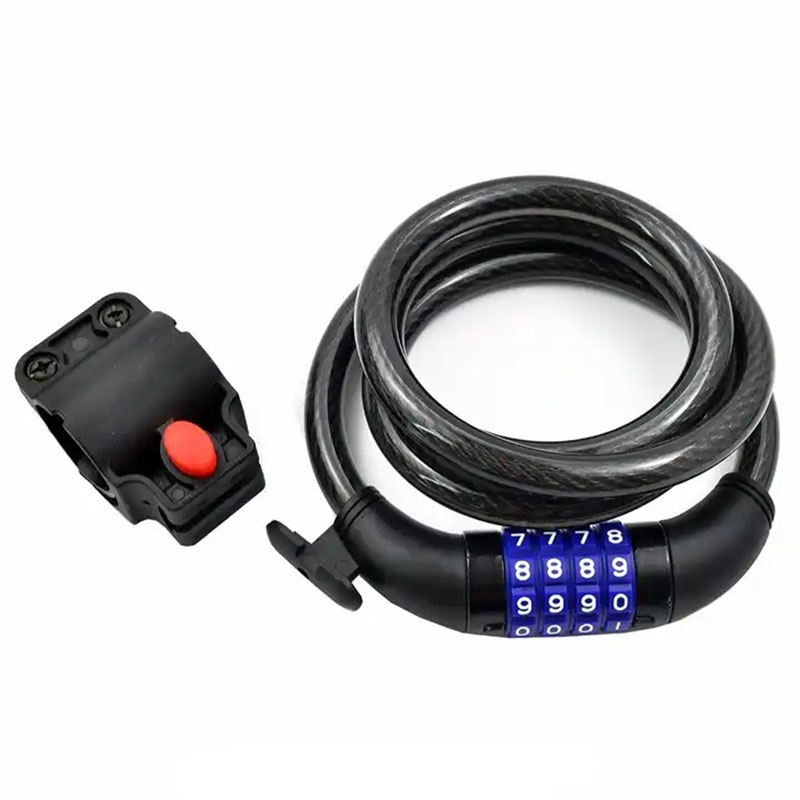
केबल ताले में मजबूत होते हैं, लचीली केबल ब्रेडेड स्टील या प्रबलित सामग्री से बने. वे अक्सर एक एकीकृत कुंजी या संयोजन लॉकिंग तंत्र के साथ आते हैंएस, उपयोग के दौरान सुविधा प्रदान करना. तथापि, वे स्टैंडअलोन सुरक्षा उपायों के बजाय द्वितीयक ताले के रूप में सबसे अच्छा उपयोग किए जाते हैं.
आवेदन करने के लिए आकार की सिफारिश करें
अनचाहे केबल लॉक कम जोखिम वाले वातावरण में हेलमेट या काठी जैसे सामान हासिल करने के लिए उपयुक्त हैं. आम तौर पर, एक मध्यम-लंबाई केबल लॉक लगभग 10-12 मिमी मोटाई पर्याप्त रूप से साइकिल या स्कूटर को बाइक रैक या पोस्ट के लिए सुरक्षित करती है. तथापि, मोटरसाइकिल को लॉक करने के लिए अकेले एक केबल लॉक बुद्धिमान नहीं हो सकता है, इस प्रकार आपको इसे द्वितीयक ताले या भारी-शुल्क बाइक ताले के साथ संयोजित करना चाहिए.
पक्ष - विपक्ष
| पेशेवरों | दोष |
| ● दृश्य निवारक ● ऑन-द-गो साइकिल चालकों के लिए हल्के और अत्यधिक पोर्टेबल ● एक साथ कई बाइक घटकों को सुरक्षित करने के लिए पर्याप्त लचीला ● कम जोखिम वाले क्षेत्रों में अल्पकालिक स्टॉप के लिए आदर्श | ● बुनियादी उपकरणों का उपयोग करके चोरों द्वारा आसानी से काटने की संभावना है ● उच्च-चोरी क्षेत्रों में स्टैंडअलोन सुरक्षा उपायों के रूप में अनुशंसित नहीं ● लापरवाह लॉक प्लेसमेंट अंतराल छोड़ सकता है, बाइक और ऑब्जेक्ट/स्टैंड के बीच उत्तोलन या काटने के हमलों को सक्षम करना ● चेन लिंक को उजागर करते समय असावधान लॉक का उपयोग सुरक्षात्मक या पहने हुए प्लास्टिक आस्तीन के बिना बाइक पेंटवर्क को नुकसान पहुंचा सकता है |
तह ताले
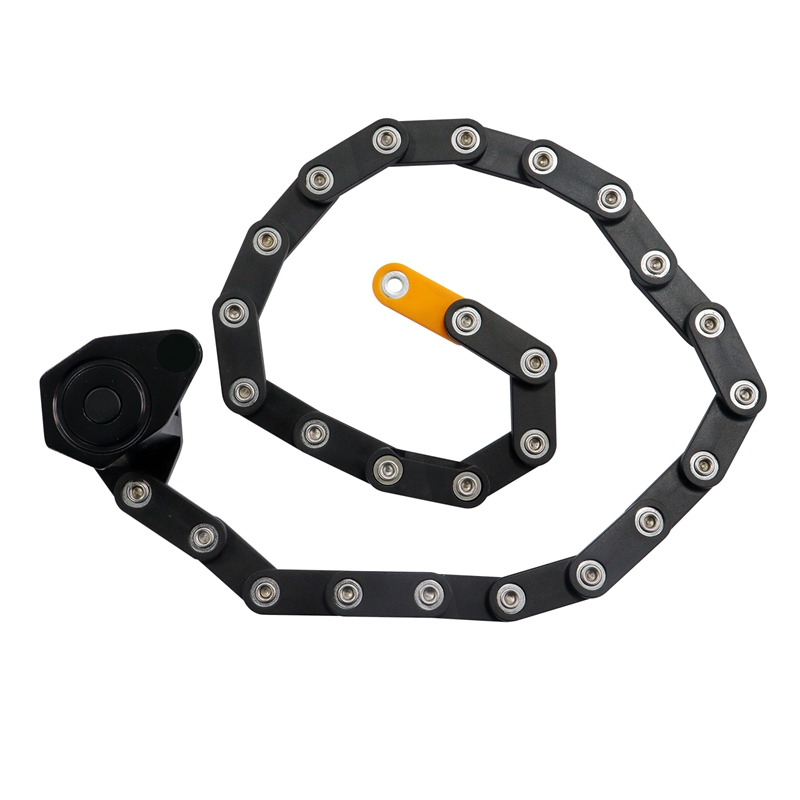
चक्रों के लिए तह ताले एक फोल्डेबल डिज़ाइन का दावा करते हैं, कई खंडों के साथ जो एक सुरक्षित लॉकिंग तंत्र बनाने के लिए प्रकट होते हैं, कॉम्पैक्ट भंडारण और पोर्टेबिलिटी सुनिश्चित करना. सख्त स्टील या मिश्र धातु सामग्री शामिल है, वे टिकाऊ हैं और उपकरण काटने के लिए प्रतिरोधी हैं. विभिन्न बाइक फ्रेम आकारों को फिट करने के लिए डिज़ाइन किया गया, वे एक अचल वस्तु के लिए बाइक को सुरक्षित करते हैं.
आवेदन करने के लिए आकार की सिफारिश करें
नियमित रूप से, कई स्टील बार के साथ एक मध्यम आकार का फोल्डिंग लॉक और लगभग 80-100 सेमी की कुल लंबाई निश्चित वस्तुओं के लिए साइकिल या स्कूटर हासिल करने के लिए उपयुक्त है. लेकिन अगर आप मोटरसाइकिल को लॉक करना चाहते हैं, आप इसे केवल इसकी आकार सीमा के कारण एक अतिरिक्त विकल्प के रूप में सेवा कर सकते हैं. इसे भारी-भरकम-शुल्क ताले के साथ संयोजित करना बेहतर होगा.
पक्ष - विपक्ष
| पेशेवरों | दोष |
| ● पोर्टेबल और लाइटवेट ● बहुमुखी लॉकिंग विकल्प ● बोल्ट कटर के लिए प्रतिरोधी ● विभिन्न बाइक फ्रेम आकारों के लिए उपयुक्त | ● पारंपरिक ताले की तुलना में सीमित लंबाई ● जाम को रोकने के लिए अतिरिक्त देखभाल की आवश्यकता हो सकती है ● बुनियादी केबल लॉक की तुलना में उच्च लागत ● कुछ मॉडल समय के साथ जंग का खतरा हो सकते हैं |
चेन लॉक
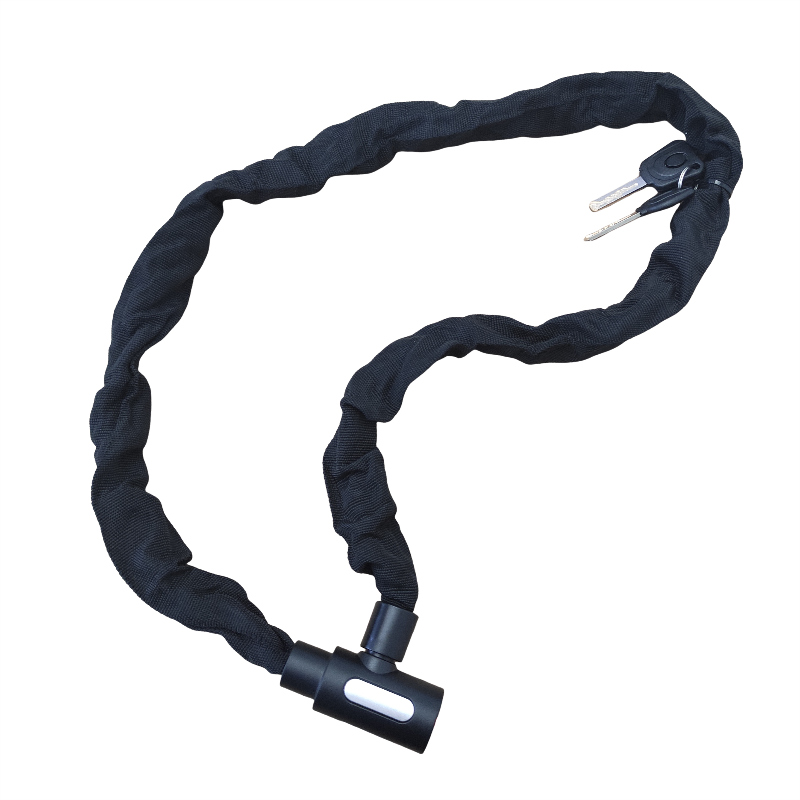
एक चेन लॉक, आमतौर पर श्रृंखला और पीतल या स्टील के लिए कठोर स्टील से बना, साइकिल के लिए एक सुरक्षा श्रृंखला उपकरण है, मोटरसाइकिल, और अन्य मूल्यवान वस्तुएं. इसमें आमतौर पर इंटरलॉकिंग लिंक के साथ एक स्टील श्रृंखला होती है और मौसम प्रतिरोधी कोटिंग्स के साथ भारी शुल्क वाले पैडलॉक होते हैं. सुविधाओं में स्थायित्व शामिल है, काटने और छेड़छाड़ के लिए प्रतिरोध, और विभिन्न वस्तुओं को हासिल करने के लिए लचीलापन.
आवेदन करने के लिए आकार की सिफारिश करें
आम तौर पर, एक सुरक्षा चेन लॉक लगभग 90-120 मिमी की लंबाई और 8-12 मिमी मोटाई में बाइक रैक या पोल जैसी निश्चित वस्तुओं के लिए साइकिल सुरक्षित करने के लिए उपयुक्त है. लंबाई में एक साइकिल के समान, 10-14 मिमी के साथ एक मोटी श्रृंखला स्कूटर के लिए बेहतर हो सकती है. एक चेन लॉक कम से कम 120 सेमी या उससे अधिक और 12-16 मिमी मोटाई मोटरसाइकिल के बड़े आकार को समायोजित करता है.
पक्ष - विपक्ष
| पेशेवरों | दोष |
| ● टिकाऊ और काटने या छेड़छाड़ के लिए प्रतिरोधी ● संभावित चोरों के लिए एक दृश्यमान निवारक प्रदान करता है ● विभिन्न स्थानों में विभिन्न वस्तुओं को सुरक्षित करने में लचीलापन प्रदान करता है | ● ले जाने के लिए बोझिल हो सकता है ● प्रभावी उपयोग के लिए एक उपयुक्त लंगर बिंदु की आवश्यकता है ● मौसम के संपर्क में समय के साथ गिरावट हो सकती है |
चार प्रकार के बाइक ताले के साथ तुलना
आपको फोल्डिंग लॉक की व्यापक समझ है, यू-ताले, चेन लॉक, या केबल लॉक, लेकिन क्या आप जानते हैं कि क्या बेहतर है? आइए अपनी आवश्यकताओं के लिए सबसे प्रभावी बाइक लॉक निर्धारित करने के लिए उनकी सामग्री संरचना और लॉकिंग तंत्र का पता लगाएं.
भौतिक शक्ति
चक्रों के लिए यू-लॉक या डी-लॉक, जैसे कि टीपी -610866, कटिंग टूल्स और ब्रूट फोर्स अटैक का विरोध करने के लिए एक बढ़ते ब्रैकेट के साथ कठोर स्टील का घमंड करें, कई संभावित चोरों को खत्म करना.
वहीं दूसरी ओर, तह ताले में कठोर स्टील या मिश्र धातु की सुविधा है, चोरी के प्रयासों के खिलाफ एक मजबूत बाधा सुनिश्चित करना.
चेन लॉक की तरह टीपी -610606 आमतौर पर कठोर स्टील से बने होते हैं, बोल्ट कटर या आरी जैसे उपकरणों को काटने के लिए उच्च तन्य शक्ति और प्रतिरोध प्रदान करना. अलावा, कुछ संयोजन श्रृंखला ताले स्थायित्व और सुरक्षा को बढ़ाने के लिए अतिरिक्त सुदृढीकरण परतें या मिश्र धातुओं की सुविधा दे सकते हैं.
तथापि, जबकि सुविधाजनक है, एंटी-चोरी केबल ताले अक्सर सामग्री की ताकत से समझौता करते हैं, उन्हें हमलों को काटने और उच्च जोखिम वाले वातावरण में उनकी प्रभावशीलता को कम करने के लिए अधिक संवेदनशील बनाना.
लॉकिंग तंत्र
यू-लॉक या डी-लॉक एक सीधा अभी तक प्रभावी लॉकिंग तंत्र का उपयोग करते हैं, एक कठोर झोंपड़ी या एक लॉक कुंजी के साथ जो एक क्रॉसबार में लॉक हो जाता है. यह डिजाइन एक सुरक्षित लंगर बिंदु प्रदान करता है. उदाहरण के लिए, सस्ती बाइक लॉक टीपी -610853 प्रदान 3 लापता कुंजियों से बचने के लिए अतिरिक्त कुंजियाँ, कम जोखिम वाले क्षेत्रों में छात्रों या यात्रियों के लिए आदर्श.
तह ताले, वहीं दूसरी ओर, परस्पर जुड़े खंडों की एक श्रृंखला को नियोजित करें जो एक सुरक्षित लॉकिंग तंत्र बनाने के लिए प्रकट होता है. उदाहरण के लिए, टीपी -610925 विशेषताएँ 27 परस्पर जुड़े नोड्स और एक डिजिटल संयोजन लॉक, साइकिल चालकों को विभिन्न पदों पर अपनी बाइक सुरक्षित करने के लिए.
चेन लॉक आमतौर पर कुंजी या संयोजन तंत्र के साथ पैडलॉक का उपयोग करते हैं. उनके पैडलॉक हमलों का विरोध करने के लिए झोंपड़ी और एंटी-ड्रिल प्लेटों का दावा करते हैं, और उन्नत मॉडल पिक या हेरफेर के खिलाफ अतिरिक्त सुरक्षा के लिए डिस्क हिरासत में या सिलेंडर ताले को शामिल कर सकते हैं.
जबकि उनके लचीलेपन के कारण सुविधाजनक है, केबल ताले एक कम सुरक्षित लॉकिंग तंत्र प्रदान करते हैं. तथापि, जैसे संयोजन ताले के साथ मोटरसाइकिल के लिए कुछ तार केबल ताले टीपी -610926 कुंजी दोष के लिए बनाओ (एक पेन कुंजी लॉक चुन सकता है). वे आपको केवल बाइक को अनलॉक करने की अनुमति देते हैं 3 डिजिटल पासवर्ड.
बाइक सुरक्षा के लिए सही कैसे चुनें?
अपनी सुरक्षा आवश्यकताओं के लिए सर्वश्रेष्ठ साइकिल लॉक का चयन करते समय, चोरी के खिलाफ व्यापक सुरक्षा सुनिश्चित करने के लिए कई कारकों पर विचार किया जाना चाहिए.
अपनी सुरक्षा आवश्यकताओं का आकलन करें
बाइक लॉक प्रकार की पसंद को स्थान द्वारा निर्धारित विशिष्ट सुरक्षा आवश्यकताओं के अनुरूप होना चाहिए. शहरी क्षेत्रों में बाइक चोरी की उच्च दरों के साथ, एक मजबूत और लचीला ताला जैसे कि यू-लॉक या डी-लॉक मूल्यवान बाइक को प्रभावी ढंग से सुरक्षित रखने के लिए अनिवार्य है. वहीं दूसरी ओर, ग्रामीण सेटिंग्स में जहां चोरी की घटनाएं कम हो सकती हैं, साइकिल चालक चेन लॉक की तरह अधिक बहुमुखी और हल्के विकल्प का विकल्प चुन सकते हैं, एक केबल लॉक, या सुरक्षा से समझौता किए बिना एक तह लॉक.
संतुलन सुरक्षित और सुविधा
साइकिल चालक अक्सर उन परिदृश्यों का सामना करते हैं जहां उन्हें दिन भर में कई बार अपनी बाइक को सुरक्षित करने की आवश्यकता होती है, जैसे कि काम के दौरान या गलत चलता है. इसलिए, बाइक लॉक चुनते समय सुविधा के साथ संतुलन बनाना भी उतना ही महत्वपूर्ण है. यदि आप दिन में एक या दो बार बाइक को लॉक करते हैं, डी-लॉक या यू-लॉक के साथ एक संयोजन चेन लॉक ठीक होगा. लेकिन अगर आप बाइक को बंद कर देते हैं 3 टाइम्स, एक व्यक्तिगत डी-लॉक, U लॉक, या तह लॉक बेहतर होगा.
बाइक मूल्य का अनुमान लगाएं
उच्च-मूल्य वाली साइकिल वारंट मजबूत और मजबूत ताले जो चोरी के प्रयासों के खिलाफ बढ़ी हुई सुरक्षा प्रदान करते हैं. के साथ -साथ, निम्न-मूल्य बाइक मध्यम सुरक्षित ताले के साथ पर्याप्त हो सकती है जो अवसरवादी चोरों के खिलाफ पर्याप्त निरोध प्रदान करती हैं.
निष्कर्ष
बाइक ताले की इस खोज के दौरान, यह स्पष्ट हो जाता है कि प्रत्येक लॉक प्रकार के पास विशिष्ट सुरक्षा चिंताओं को दूर करने के लिए डिज़ाइन किए गए अद्वितीय विशेषताएं और अनुप्रयोग हैं.
You डी-लॉक या यू-बोल्ट बाइक ताले अपने मजबूत निर्माण और काटने के उपकरण के प्रतिरोध के लिए बाहर खड़े हैं, उन्हें उच्च जोखिम वाले शहरी सेटिंग्स के लिए आदर्श बनाना.
The तब तह ताले बहुमुखी प्रतिभा और सुरक्षा लाभ प्रदान करते हैं, कॉम्पैक्ट की तलाश में साइकिल चालकों को खानपान अभी तक मजबूत लॉकिंग सॉल्यूशंस.
। इसके अलावा, चेन लॉक कठोर स्टील निर्माण के साथ स्थायित्व प्रदान करते हैं, शहरी सुरक्षा आवश्यकताओं के लिए आदर्श. यह बहुमुखी वस्तु सुरक्षा प्रदान करते हुए उपकरण काटने का विरोध करता है.
। इस बीच, केबल लॉक कम जोखिम वाले क्षेत्रों में सामान हासिल करने के लिए हल्के और लचीले विकल्प प्रदान करते हैं, लेकिन स्टैंडअलोन सुरक्षा उपायों के रूप में अनुशंसित नहीं हैं.
इसलिए, आपको कुछ से बाइक लॉक करना चाहिए अच्छी बाइक लॉक ब्रांड या उन्हें व्यक्तिगत जरूरतों के आधार पर बेचते हैं, साइकिल चालकों को बाइक चोरी के खतरनाक खतरे को कम करने और उनकी सवारी के दौरान मन की अधिक शांति का आनंद लेने के लिए सक्षम करना.
उपवास
1. कौन सा लॉक अटूट है?
कोई भी ताला वास्तव में अटूट नहीं है, जैसा कि किसी भी ताला से पर्याप्त समय दिया जा सकता है, औजार, और दृढ़ संकल्प. तथापि, कुछ ताले, कठोर स्टील निकायों और जटिल कुंजी प्रणालियों के साथ उच्च-सुरक्षा पैडलॉक की तरह, चुनने के लिए महत्वपूर्ण प्रतिरोध प्रदान करें, कटिंग, और अन्य छेड़छाड़ के तरीके.
2. सुरक्षा के किस स्तर पर बाइक के ताले हैं?
बाइक के ताले को कांस्य के पैमाने पर वर्गीकृत किया जाता है, चाँदी, सोना, और हीरा, उच्च रेटिंग के साथ उच्च सुरक्षा स्तरों का संकेत मिलता है. स्तर इस बात पर आधारित हैं कि लॉक को तोड़ने में चोर को कितना समय लगेगा:
1. पीतल: कम/मध्यम सुरक्षा, अवसरवादी अपराध को रोकने के लिए डिज़ाइन किया गया
2. चाँदी: मध्यम/उच्च सुरक्षा, एक अधिक निर्धारित हमले को रोकने के लिए डिज़ाइन किया गया
3. सोना: अधिकतम सुरक्षा, समर्पित हमलों को रोकने के लिए डिज़ाइन किया गया
4. डायमंड: अंतिम प्रतिभूति, सबसे विनाशकारी हमलों को रोकने के लिए डिज़ाइन किया गया

